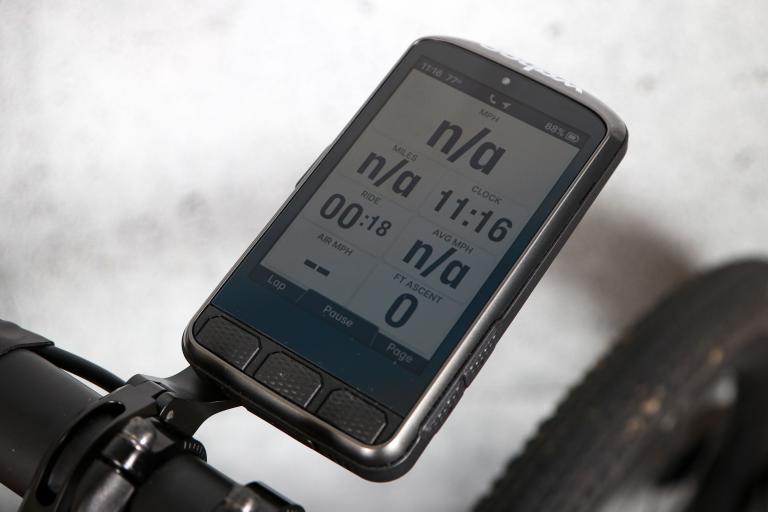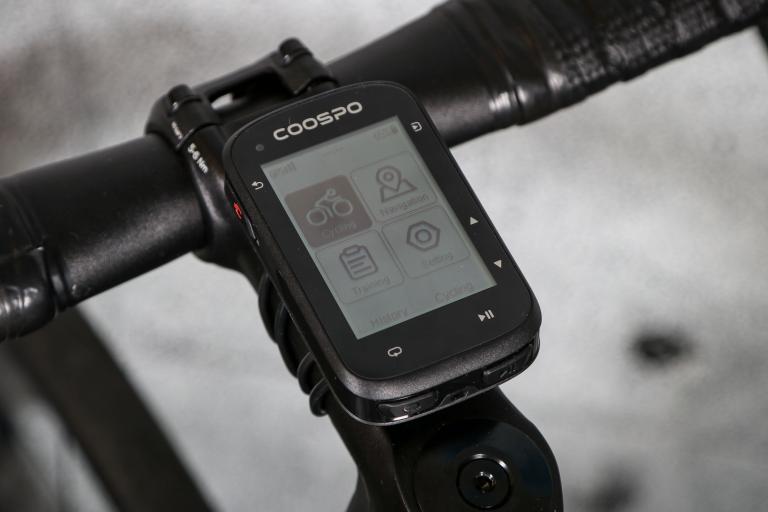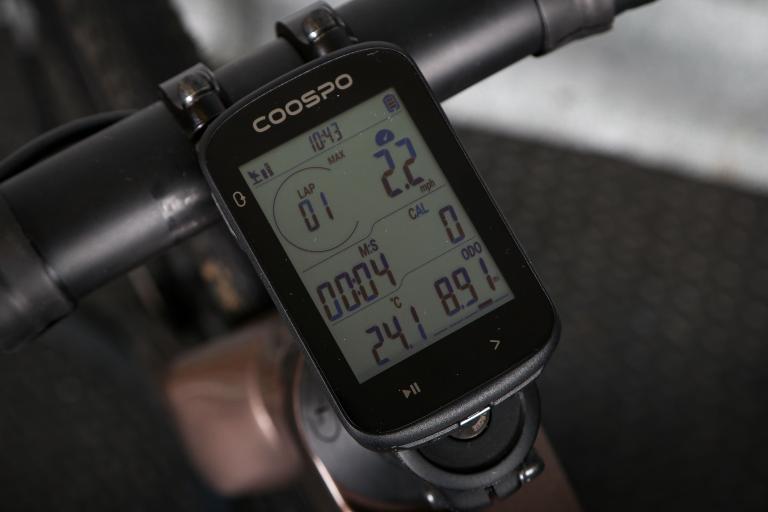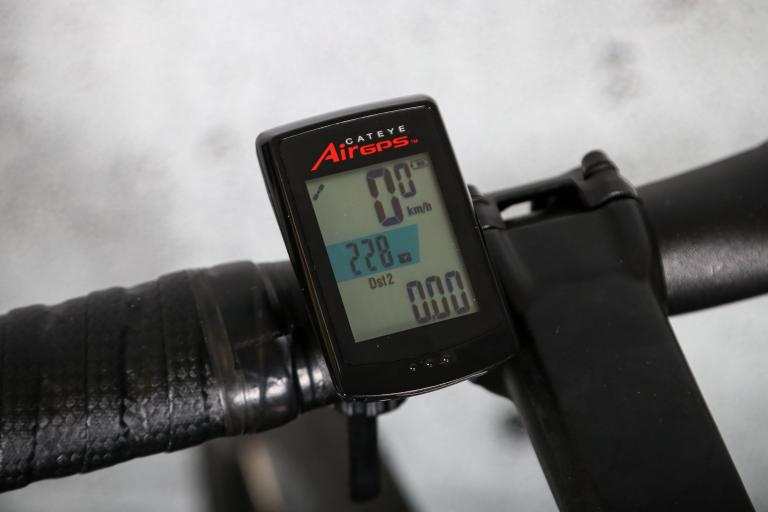- News
- Reviews
- Bikes
- Components
- Bar tape & grips
- Bottom brackets
- Brake & gear cables
- Brake & STI levers
- Brake pads & spares
- Brakes
- Cassettes & freewheels
- Chains
- Chainsets & chainrings
- Derailleurs - front
- Derailleurs - rear
- Forks
- Gear levers & shifters
- Groupsets
- Handlebars & extensions
- Headsets
- Hubs
- Inner tubes
- Pedals
- Quick releases & skewers
- Saddles
- Seatposts
- Stems
- Wheels
- Tyres
- Tubeless valves
- Accessories
- Accessories - misc
- Computer mounts
- Bags
- Bar ends
- Bike bags & cases
- Bottle cages
- Bottles
- Cameras
- Car racks
- Child seats
- Computers
- Glasses
- GPS units
- Helmets
- Lights - front
- Lights - rear
- Lights - sets
- Locks
- Mirrors
- Mudguards
- Racks
- Pumps & CO2 inflators
- Puncture kits
- Reflectives
- Smart watches
- Stands and racks
- Trailers
- Clothing
- Health, fitness and nutrition
- Tools and workshop
- Miscellaneous
- Buyers Guides
- Features
- Forum
- Recommends
- Podcast
review
£44.95
VERDICT:
Easy to read and intuitive to use, but expensive, given the specification/functions
Weight:
41g
Contact:
At road.cc every product is thoroughly tested for as long as it takes to get a proper insight into how well it works. Our reviewers are experienced cyclists that we trust to be objective. While we strive to ensure that opinions expressed are backed up by facts, reviews are by their nature an informed opinion, not a definitive verdict. We don't intentionally try to break anything (except locks) but we do try to look for weak points in any design. The overall score is not just an average of the other scores: it reflects both a product's function and value – with value determined by how a product compares with items of similar spec, quality, and price.
What the road.cc scores meanGood scores are more common than bad, because fortunately good products are more common than bad.
- Exceptional
- Excellent
- Very Good
- Good
- Quite good
- Average
- Not so good
- Poor
- Bad
- Appalling
The Cat Eye Quick Cycling Computer is a simple 7 function model, with a unique 'lollipop' design and very clear display. Its intuitive to use, easy to read and well-made, despite weighing a feathery 41g. However, despite considerable charm, there's no getting away from the fact that it is pricey, relative to the functions you get and the competition.
Pros: Clear, simple, well-made and easy to use.
Cons: Expensive, relative to the spec.
Specification
OK, so the Quick is a wireless model offering current, maximum, and average speed, total distance, moving time and clock. Then there's auto stop/start and pacer arrows denoting when you're exceeding, maintaining or dipping below your average speed. Most computers have a maximum speed of 99.9mph. The Quick is 62.2mph, which should be adequate for most riders, especially on a commute.
Design
The first thing that struck me was just how sleek it looks. Admittedly, the stalk type 'Out front' mount doesn't look particularly aero. However, it ensures the computers' angle is easily adjusted and lodges snugly against the stem, maximising available bar space.
Staying with the mount, it fits 31.8 bars, but a shim is included for 25-26.0. Narrower sections (such as those found on the latest generation of riser-type drops) may require something thicker but nothing a quick rummage in the bodge box won't remedy. The clamp is held together by a 2.5mm Allen bolt. The head unit is easily removed, say when locking in the street, or changing batteries. Simply press a button in the bracket and pull upward.
Talking of batteries, both the head unit and analogue fork sensor use the coin type CR1616 cells. The head unit is reckoned to last a year (Based on an hour's daily use), the sensor 6,250 miles. Batteries are easily accessed (simply slide 10p coin, or replacement battery into the slot and twist). A precautionary lick of Vaseline on the contacts never hurts, but both units seem genuinely well sealed against the elements.
The sensor tethers to the fork via rubberised 'foot' and cable ties. Messier perhaps, but ensures a universal fit, especially to oversized blades, such as my Univega's. The beefy spoke magnet probably helps, but a consistent, reliable readout isn't dependent on these components running a hairs breadth from each other.
Setup
Instructions are very clear and the unit intuitive to setup. Literally a question of pressing mode, choosing KMH/MPH, Wheel/Tyre size etc, adjusting the numbers, then pressing menu to confirm. Straight from the box, I was ready to ride in 20minutes.
Display
The Champagne digits on a black background are crystal clear and seems unaffected by extremes-bright sunlight, dusk etc. Its also useable at night-without a backlight function. There are two rows of data-speed/distance/clock etc with pacer arrows egging you on. Just press the mode button to cruise through these, as required.
Response/Accuracy
The auto stop/start function is reassuringly sensitive, I've found the unit pickup within the wheel's first revolution and there's been no lag whatsoever. Just a very consistent and accurate readout, with the pacer arrows doing their nagging duty extremely effectively.
Strong magnetic fields, such as those generated by old fashioned Magnox nuclear power stations, and even some hub dynamos, were enough to meddle with older wireless computer sensors. (I Recall a few 89mph readouts, on the flat, while towing my son on his tagalong!).
The Quick never missed a beat, regardless of riding conditions. Controls are easy to use even in full-finger, middleweight gloves. Though the mode button is stealthy, its easily located and cruising through the modes, to check other data was effortless, even when hustling down a 1in7. I've been out on a few late-night rides; mercury sliding to zero-no problems whatsoever.
Weatherproofing/Durability
Most bike computers are well sealed these days. Ours passed my sustained, close range garden hose torture test with flying colours. Plastics and display show no evidence of swirls/scratching despite the head unit holidaying in pockets and my love of mixed terrain riding.
Value
Here's the rub. You can get similar functionality for considerably less. Indeed, you needn't look further than Cat Eye's one range. Notably the Cat Eye Strada Slim and Cat Eye Velo Wireless (£32.68 and £25 respectively). Then of course, we have the BTwin 500.
Direct comparison is a little tricky, since the Quick has two functions more than this but the BTwin is less than half the Quick's rrp. On balance, I'd like a computer with cadence, but I've genuinely used all the Quick's functions, pretty much every ride. Despite its charms, I'd struggle to justify full ticket price for this level of spec.
Conclusion
I have a soft spot for the Quick. It's intuitive to set up, use and may be all some riders require. £28-30, I'd say higher than average, but still fair. However, despite some neat features, I'd struggle to recommend it over something like the Strada Slim, or the Velo 9 wireless.
Verdict
Easy to read and intuitive to use, but expensive, given the specification/functions
road.cc test report
Make and model: Cateye Quick Computer
Size tested: One
Tell us what the product is for and who it's aimed at. What do the manufacturers say about it? How does that compare to your own feelings about it?
Cat Eye Says "Wireless, weather-proof and easy to read, the sleekly designed Quick cyclocomputer with integrated out-front bracket measures your speed and distance giving you the edge on your daily commute and beyond.
Good Design Award 2018 and iF Design Award 2019 winner". My feelings "Simple littler computer that is intuitive to setup and use. However, pricey relative to the specification and competitors".
Tell us some more about the technical aspects of the product?
Functions
* Current / average / maximum speed
* Trip distance
* Total distance
* Moving time
* Clock
Features
* Analog wireless
* Easy to read inverted LCD
* Auto start / stop
* Menu screen to change setting
* Programmable odometer
* Battery indicator
* Sleek design with integrated out-front bracket (head unit is removable from the bracket)
* Current speed:
* 0.0 (4.0) – 99.9 km/h / [0.0 (3.0) – 62.0 mph]
* Total distance (Odometer):
* 0.0 – 9999.9 / 10000 – 99999 km [mile]
* Trip distance:
* 0.00 – 999.99 km [mile]
* Moving time:
* 0:00'00' – 9:59'59'
* Average speed:
* 0.0 – 99.9 km/h / [0.0 – 62.0 mph]
* Maximum speed:
* 0.0 (4.0) – 99.9 km/h / [0.0 (3.0) – 62.0 mph]
* Wireless transmission:
* Speed [analog sensor]
* Clock:
* 0:00'~23:59' [1:00'~12:59']
* Pace arrow:
* Yes
* Auto power saving:
* Yes
* Auto start/stop:
* Yes
* Odometer manual set:
* Yes
* Tire size:
* 100mm~3999mm (default:2096mm)
* Battery:
* Computer : CR1616 X1
Sensor:CR2032 X1
* Battery life:
* Computer (1hr use per day): approx 1 year
Sensor: approx 10,000 km [6,250 miles] in total distance
* Dimension / Weight:
* 93.5 X 54 X 36mm / 24g
Rate the product for quality of construction:
7/10
Lightweight but composites feel surprisingly solid.
Rate the product for performance:
8/10
Does the basics very well and accurately.
Rate the product for durability:
6/10
Composites seem sturdy and well sealed against the elements.
Rate the product for weight (if applicable)
8/10
41g complete.
Rate the product for comfort (if applicable)
7/10
Easy to read, even in poor light and simple to use, even at speed.
Rate the product for value:
3/10
By no means poor in terms of build quality, function/performance. However, expensive relative to the specification.
Tell us how the product performed overall when used for its designed purpose
Overall, the Cat Eye Quick has been really easy to read and use. Data seem very accurate and the unit unaffected by electrical interference (e,g. Pylons, electricity substations etc). Heart rate monitors and indeed, hub dynamos haven't created any mischief either. (This is not always the case, with some budget wireless models). 62mph maximum readout might seem a little low. However, in real terms, should be practical for most riders and situations.
Tell us what you particularly liked about the product
Crystal clear display, lightweight and ease of use.
Tell us what you particularly disliked about the product
Price, especially relative to the specification. A backlight might put a dent in battery life, but would be welcomed on night rides.
How does the price compare to that of similar products in the market, including ones recently tested on road.cc?
Price is steep, taking into account models with similar functions. Notably the Cat Eye Strada Slim and Cat Eye Velo Wireless (£32.68 and £25 respectively).
Did you enjoy using the product? Yes
Would you consider buying the product? Yes but at a generous discount.
Would you recommend the product to a friend? Possibly but not at full rrp
Use this box to explain your overall score
I really like the Quick. Its pleasant and easy to use. However, its is very expensive, relative to the specification, that's what drops the overall mark down - at a similar price to other computers with similar functions it's a 9 out of 10 proposition - worth bearing in mind if you spot one at a discount.
About the tester
Age: 45
I usually ride: Rough Stuff Tourer Based around 4130 Univega mtb Frameset My best bike is: 1955 Holdsworth Road Path and several others including cross & traditional road
I've been riding for: Over 20 years I ride: Most days I would class myself as: Experienced
I regularly do the following types of riding: cyclo cross, commuting, touring, fixed/singlespeed, mtb,
Shaun Audane is a freelance writer/product tester with over twenty-eight years riding experience, the last twelve (120,000 miles) spent putting bikes and kit through their paces for a variety of publications. Previous generations of his family worked at manufacturing's sharp end, thus Shaun can weld, has a sound understanding of frame building practice and a preference for steel or titanium framesets.
Citing Richard Ballantine and an Au pair as his earliest cycling influences, he is presently writing a cycling book with particular focus upon women, families and disabled audiences (Having been a registered care manager and coached children at Herne Hill Velodrome in earlier careers)
Latest Comments
- eburtthebike 1 sec ago
"......disgruntled residents continuing their protests by chaining bicycles the trees,..."...
- Secret_squirrel 6 min 34 sec ago
All competing for a role in a group that has been accused of being involved in massive corruption in the past. Hmm.
- Cycle Happy 38 min 35 sec ago
I've found the Chilli-Tech rear camera /light combo to be very good. ...
- quiff 1 hour 10 min ago
I was intrigued as to what, if any, connection the term has to Mongolia. According to, ahem, Wikipedia, Down himself (namesake of the syndrome)...
- Davisian 1 hour 49 min ago
I don't know why this is in the news, the Merseyside area is peppered with crossings that work like this and have done for decades. Maybe we don't...
- stonojnr 1 hour 59 min ago
at Man Utd its more about managing the bags of wind who used to play the game but now endlessly criticise from the comfy pundit sofa, than anyone...
- wtjs 3 hours 3 min ago
The cyclist told road.cc that he has not reported the near miss to the City of London Police because “what’s the point? They’re not interested...
- chrisonabike 3 hours 20 min ago
Never mind all that now - do people have any opinion on pet-cycling-safety?...
- chrisonabike 4 hours 20 min ago
That's clearly far too large a vehicle to transport pets in urban areas. What about a Ram (perhaps more suited to country types though)?
- Tom_r_k 4 hours 27 min ago
Brilliant to see a company showing some love to rim brakes. I have been tempted to get some soon so may support a company offering fresh updates...






Add new comment
6 comments
My first bike computer was a CatEye wireless. Unfortunately, I couldn't use it in the dark as the light that I was using interfered with the signal from the wireless sensor and the unit constantly told me I was going 40 mph.
Presumably it was designed for use at night as it had a backlight.
I assume at some point that has been solved?
I've got a Cateye Velo 9 on my commuter, I think I only paid about £9 for it, mainly used as an odometer, but has a nice big display and has everything I need on that bike. I just zip-tied the hot shoe bracket onto a Garmin outfront mount and it sits there just fine without shifting. Now if only you could download the data from the unit, it would be perfect.
62.2mph, which should be adequate for most riders.....
Dont think ive been over 50mph nor would I want to, I dont even know what bicycle tyres are rated up to
Well, I can see it for £33 on Bike24. I like the look of it, I'm a huge fan of Cateye components, but I'll wait for a cadence version to arrive.
Meanwhile my Raleigh Echo W1 which I paid about £10 in the mid 00s is still going strong on my commuter, batteries last 3 years easily and the button batts in the sensor last an absolute dogs age. I recently invested in a few Sigma 9.16, nice basic computers but damn accurate, you can get them for £23 posted, maybe cheaper if you look around
this Cateye is ridiculously overpriced using the outfront bit as the premium factor, my first computer was a Cateye Vectra some 29 years ago and generally Cateye make some good kit but this looks cheap/plasticky/shit.
Looks cool and love the design. Happily pay £45..in fact i think i will